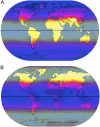Colloquium paper: human skin pigmentation as an adaptation to UV radiation
- PMID: 20445093
- PMCID: PMC3024016
- DOI: 10.1073/pnas.0914628107
Colloquium paper: human skin pigmentation as an adaptation to UV radiation
Abstract
Human skin pigmentation is the product of two clines produced by natural selection to adjust levels of constitutive pigmentation to levels of UV radiation (UVR). One cline was generated by high UVR near the equator and led to the evolution of dark, photoprotective, eumelanin-rich pigmentation. The other was produced by the requirement for UVB photons to sustain cutaneous photosynthesis of vitamin D(3) in low-UVB environments, and resulted in the evolution of depigmented skin. As hominins dispersed outside of the tropics, they experienced different intensities and seasonal mixtures of UVA and UVB. Extreme UVA throughout the year and two equinoctial peaks of UVB prevail within the tropics. Under these conditions, the primary selective pressure was to protect folate by maintaining dark pigmentation. Photolysis of folate and its main serum form of 5-methylhydrofolate is caused by UVR and by reactive oxygen species generated by UVA. Competition for folate between the needs for cell division, DNA repair, and melanogenesis is severe under stressful, high-UVR conditions and is exacerbated by dietary insufficiency. Outside of tropical latitudes, UVB levels are generally low and peak only once during the year. The populations exhibiting maximally depigmented skin are those inhabiting environments with the lowest annual and summer peak levels of UVB. Development of facultative pigmentation (tanning) was important to populations settling between roughly 23 degrees and 46 degrees , where levels of UVB varied strongly according to season. Depigmented and tannable skin evolved numerous times in hominin evolution via independent genetic pathways under positive selection.
Conflict of interest statement
The authors declare no conflict of interest.
Figures


References
-
- Darwin C. The Descent of Man, and Selection in Relation to Sex. London: John Murray; 1871.
-
- Desmond AJ, Moore JR. Darwin's Sacred Cause: How a Hatred of Slavery Shaped Darwin's Views on Human Evolution. Boston, MA: Houghton Mifflin Harcourt; 2009.
-
- van Wyhe J. Mind the gap: Did Darwin avoid publishing his theory for many years? Notes and Records of the Royal Society. 2007;61:177–205.
-
- Isaac B. The Invention of Racism in Classical Antiquity. Princeton, NJ: Princeton University Press; 2004.
-
- Smith SS, Jordan W-D. An Essay on the Causes of the Variety of Complexion and Figure in the Human Species. Cambridge, MA: The Belknap Press of Harvard University Press; 1965.
MeSH terms
Substances
LinkOut - more resources
Full Text Sources
Other Literature Sources
Research Materials

